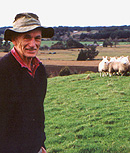The Cheviot Hills are in the north of England on the Scottish border, and it has been written that in 1372 there was a small but very hardy race of sheep, found grazing over large tracts of them. Tradition states that they came from out of the sea.
There may well be an element of truth in that. One of the Spanish Armada ships that was sent to conquer England in the days of Phillip the Second of Spain and good Queen Bess of England was wrecked on the coast of the hill country, and the sheep, which were carried for the supply of meat, swam ashore. The sheep of Spain at that time were the best in the known world.
Bred for the production of quality lambs, the Cheviot's wool was highly sought after, and was once the base for the Border Tweed industry although it has since declined to be of marginal importance in the UK. The Queen Elizabeth Castle of Mey Trust, whose president is HRH Prince of Wales, now holds as one of its objectives the preservation of the North Country Cheviot breed of sheep, and the education of the public about the origins and genealogical development both past and future.
The first report of Cheviots arriving in New Zealand was 1845, when a ram and a ewe arrived in the Nelson province aboard the 'Slains Castle'. Today there are an estimated 2-3,000 Cheviot sheep in New Zealand. They can weigh between 50-60kg, producing a wool fibre diametre of 28-33 microns with a staple length of 75-100 mm, and capable of lamb production of 120-130%.
Carl Neal from the Upper Moutere has bred the animal all his life, he bought his first Cheviots in 1947 at the age of sixteen from Rex Mexted of Levin, when he bought three ewes for 12 guineas each, and a ram for 21 guineas.
Registered with the New Zealand Sheep Breeders Association in 1948, a couple of years later the Cheviot breeders set up their own society, and Carl was the youngest foundation member, today he is the only surviving foundation member. "I'm very jealous of that fact, it's something that's very nice, to have seen it all these years," he said.
At the height of the 1970's there were 5,000 registered ewes, by the late 1990's numbers fell to 1,300, but they are back up again to 1,700 registered ewes, with 25 society members nationwide. The biggest flocks are in the Hawkes Bay, Manawatu and Southland where Carl described demand as strong.
"They are using the rams for hogget breeding because they are a very active sheep, the main point is their activity, when the lambs are born they are up and away - extremely active. There are big properties and they need quantities of rams for hogget breeding."
Carl keeps about 200 sheep on his 50 acre property, but over the many years he has owned a succession of farm properties, through hard work, improvement and development, and proudly never through the utilisation of crippling debt. He once bred up a flock of 2,500 on a Marlborough Sounds property, which he described as an ideal animal for the conditions.
"We originally had Romneys, and I have nothing against any breed of sheep, as long as you do the best you can with them. When you were mustering, Romneys always walked away from you down hill, so you always ended up with difficult animals down of the beach, or on a bluff. But once we changed over to the Cheviot cross sheep, they always walked up hill. When you turned them out into blocks, they went away from the gates."
Carl believes Cheviots have the same problems as other sheep breeds, but not as many of them. They eat different vegetation and tend to browse, and have a tremendous desire to live.
"I've never got terribly big with them, just held about 100 ewes on average. They are just a part of me, and they'll be here as long as I'm about. I still do all the work with them, and I still shear the silly brutes."
